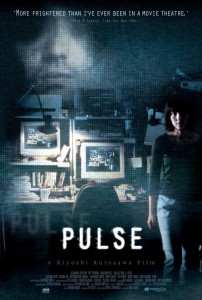Kairo (Pulse)
Written and directed by Kiyoshi Kurosawa
Japan, 2001
With our obsession of technology and isolation, would we realize it if the human race suddenly disappeared one day? We’ve spent decades refining technology that can allow us to be much more sociable, and connect with people from other parts of the world. And yet, many haven’t realized that in our efforts to somehow connect with others and build a web of friends, we’ve closed ourselves off to the world, and have completely accomplished the opposite of technology’s intent.
While surely we’ve constructed friends online and groups of people to commune with, we’re not living a social life, because we’re still just in a dark room in front of a bright screen. 2001’s Kairo focuses on a technology-obsessed world where society has closed itself off, thus failing to live the lives given to them. In an effort to breach that social network, people accidentally let in the dead from another realm. And they’ve come back to live the lives we’re taking for granted through our technology and easy applications allowing us to connect through text without connecting emotionally.
Kiyoshi Kurosawa’s Kairo surely is one of the bleaker and more horrifying of the J-Horror pictures, never quite seeming to get any better. Though the remake from America delivered a hint of hope, Kairo offers none, and gradually slips in to a dark and dreary world where humans have become stains on walls, while the dead have returned once more. A group of university students begin studying a strange series of suicides, realizing that the deaths are linked to a mysterious website offering a glimpse in to someone else’s life. What they don’t realize is that they invite in an entity that begins to slowly tear away at their will to live and their humanity. What begins as a string of unusual incidents gradually descends to more madness.
Kurosawa centers on various characters involved in the phenomenon, some of whom are devoted to figuring out the odd supernatural occurrences and why they’re chipping away at humanity, while others find themselves victims of the entities. Kurosawa consistently drapes the specters in the darkness and as blurs and mere fuzzy beings, but as the signals they originate from become stronger with every soul they destroy, and humans dissolve into black blotches on walls, the undead become a new race and decide that the city is now their own.

Immediate contact with the entities ensures a gradual death from sadness and hopelessness, and those wise enough to escape have barricaded themselves in their houses, covered in red tape. Many have explained that the red tape is a means of expressing violence and bloodshed, as most of the film is seeped with dread. Kurosawa slowly draws the curtain down on a world where technology has become the doorway, while humanity become what they’ve aspired to for decades: mere shadows on walls that could easily be forgotten or ignored.
Much of the imagery is horrifying in its sheer atmosphere and the futility of this situation, as most characters fade in to the darkness, while others begin dropping to their deaths, only to burst in to black ash before our eyes. There’s also a horrifying moment where planes begin dropping from the skies, while the dead overtake the once scenic areas of Japan like arcades and restaurants. And in one confrontation with a specter, the ghoulish being stalks a character in slow motion, revealing its horrific facade.
Kairo is a rare bit of apocalyptic horror cinema, where our ultimate undoing is our desire to become nothing but blips on screens, convincing ourselves we’re creating human connections. By the time we’ve decided to reach out and come together to figure out how to stop this ghostly menace, it’s too late. The utterly gut-wrenching final scene amidst a boat in the middle of the sea signals not only the end of Japan, but the beginning of the end of humanity all over the world.
– Felix Vasquez Jr.

